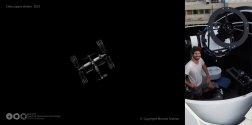Oriental Space aimed at the successful first flight of the "Gravity-1" rocket, and recently completed more than ten large-scale ground verification tests, among which The successful completion of the noise test and the hot test of the final attitude control power system marks that the rocket has completed all the development of the initial prototype and is fully preparing for the first flight mission.
The noise test is a system-level environmental test of the "Gravity-1" launch vehicle. The rocket will experience a strong noise environment during launch and flight, including the exhaust noise of the rocket during ground launch and the aerodynamic noise during high-speed flight, which may cause damage and failure of the equipment. Therefore, it is necessary to conduct a simulation test of the noise environment on the ground Check it out.
During the test, the rocket body structure, avionics system, and final attitude control power system were assembled according to the flight status, and relevant simulation media were filled in the final attitude control power system, and the avionics system was powered on for the whole process. This test has achieved the expected goal, and the environmental adaptability of structural parts, cables, pipelines, pressure vessels, and instruments and equipment on the arrow, and the reliability of the work in a vibration environment have been assessed; comprehensive data has been obtained, and the rocket flight The design of acoustic-induced vibration environmental conditions in the process has been effectively verified.
After the noise test, the impact test was completed, and then the comprehensive thermal test was carried out for the final attitude control power system. The final attitude control power system of "Gravity-1" is independently developed by the company. It uses 4 sets of 50N and 12 sets of 700N engines to provide reaction attitude control (RCS) for part of the rocket's flight process and the speed correction required for the satellite's precise orbiting.
According to the scheduled test program, the power system has completed all actions such as detonation of the electric explosion valve, system pressurization, solenoid valve switch and thrust chamber ignition. During the test run, the air and liquid pressures were normal, the solenoid valves operated normally, the ignition of the thrust chamber was reliable, each unit was matched well, and the parameter indicators met expectations; after the test run, each unit was in good condition, and the power system assembly structure was intact.
The complete success of this test run has fully verified the correctness and environmental adaptability of the final attitude control power system design, and laid a solid technical foundation for the successful first flight of the "Gravity-1" carrier rocket.























